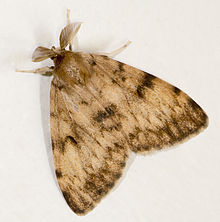Gypsy moth
| Gypsy moth | |
|---|---|
 |
|
| Adult female gypsy moth | |
 |
|
| Adult male gypsy moth | |
| Scientific classification | |
| Kingdom: | Animalia |
| Phylum: | Arthropoda |
| Class: | Insecta |
| Order: | Lepidoptera |
| Family: | Erebidae |
| Subfamily: | Lymantriinae |
| Genus: | Lymantria |
| Species: | L. dispar |
| Subspecies: | L. d. dispar |
| Trinomial name | |
|
Lymantria dispar dispar (Linnaeus, 1758) |
|
Lymantria dispar dispar, commonly known as the gypsy moth, European gypsy moth, or North American gypsy moth, is a moth in the family Erebidae that is of Eurasian origin. It has a range which covers Europe, Africa, and North America.
Carl Linnaeus first described the species Lymantria dispar in 1758. The subject of classification has changed throughout the years, resulting in confusion surrounding the species' taxonomy. This caused many references to describe this one species in different ways. The family has jumped between Lymantriidae, Noctuidae and Erebidae. Lymantria dispar dispar has been designated a sub-species of Lymantria dispar.
It is classified as a pest, and its larvae consume the leaves of over 500 species of trees, shrubs and plants. The gypsy moth is one of the most destructive pests of hardwood trees in the eastern United States.
Linnaeus first described the species Lymantria dispar in 1758. The subject of classification has changed throughout the years, resulting in confusion surrounding the species taxonomy. This caused many references to describe this one species in different ways. The family has jumped between Lymantriidae, Noctuidae and Erebidae. The species Lymantria dispar has been split into sub-species such as Lymantria dispar asiatica and Lymantria dispar japonica. Differences between the subspecies are poorly understood even at the government level.
The order Lepidoptera contains moths and butterflies characterized by having a complete metamorphosis; larvae transform to pupae and then metamorphose into adult moths or butterflies. The family is Lymantriidae. Lymantriid larvae are commonly called tussock moths because of the tufts of hair on the larvae.
Lymantriidae was separated from Lariidae and was classified as its own family by (Hampson 1893). The family Lymantriidae had previously been referred to as Orgyiidae (Wallengren 1861) and Dasychiridae (Packard 1864)), but consensus formed in favor of Lymantriidae. Lymantriidae has had numerous taxonomical changes which was solidified by Ferguson in 1978.
Lymantriidae was reclassified into the family Noctuidae in 2006. Noctuidae is defined as a group in which hindwing vein M2, originates in the lower third of the discal cell, but it is as strong as vein M3. This results in the cubital vein appearing to have four branches. The classification of Noctuidae came from Mitchel et al. (2005). Lafontaine and Fibiger (2006) agreed that Lymantriidae belonged within Noctuidae, but disagree with the classification as a subfamily. Fewer taxonomic changes are required with the reclassification of Lymantriidae being a subfamily in the monophyletic group of Noctuidae. Sources published prior to the reclassification in 2006 and shortly thereafter may refer to Lymantriidae. Lafontaine and Fibiger (2006)'s classification as a subfamily of Noctuidae has received acceptance, but is not yet universal.
...
Wikipedia
